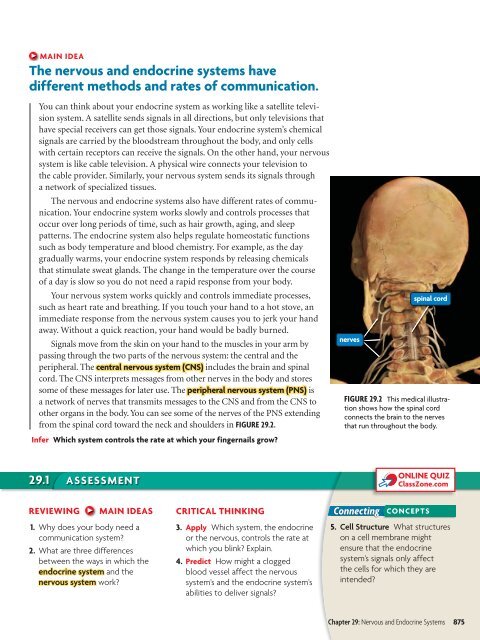Create successful ePaper yourself
Turn your PDF publications into a flip-book with our unique Google optimized e-Paper software.
MAIN IDEAThe nervous <strong>and</strong> endocrine systems havedifferent methods <strong>and</strong> rates of communication.You can think about your endocrine system as working like a satellite televisionsystem. A satellite sends signals in all directions, but only televisions thathave special receivers can get those signals. Your endocrine system’s chemicalsignals are carried by the bloodstream throughout the body, <strong>and</strong> only cellswith certain receptors can receive the signals. On the other h<strong>and</strong>, your nervoussystem is like cable television. A physical wire connects your television tothe cable provider. Similarly, your nervous system sends its signals througha network of specialized tissues.The nervous <strong>and</strong> endocrine systems also have different rates of communication.Your endocrine system works slowly <strong>and</strong> controls processes thatoccur over long periods of time, such as hair growth, aging, <strong>and</strong> sleeppatterns. The endocrine system also helps regulate homeostatic functionssuch as body temperature <strong>and</strong> blood chemistry. For example, as the daygradually warms, your endocrine system responds by releasing chemicalsthat stimulate sweat gl<strong>and</strong>s. The change in the temperature over the courseof a day is slow so you do not need a rapid response from your body.Your nervous system works quickly <strong>and</strong> controls immediate processes,such as heart rate <strong>and</strong> breathing. If you touch your h<strong>and</strong> to a hot stove, animmediate response from the nervous system causes you to jerk your h<strong>and</strong>away. Without a quick reaction, your h<strong>and</strong> would be badly burned.Signals move from the skin on your h<strong>and</strong> to the muscles in your arm bypassing through the two parts of the nervous system: the central <strong>and</strong> theperipheral. The central nervous system (CNS) includes the brain <strong>and</strong> spinalcord. The CNS interprets messages from other nerves in the body <strong>and</strong> storessome of these messages for later use. The peripheral nervous system (PNS) isa network of nerves that transmits messages to the CNS <strong>and</strong> from the CNS toother organs in the body. You can see some of the nerves of the PNS extendingfrom the spinal cord toward the neck <strong>and</strong> shoulders in FIGURE 29.2.Infer Which system controls the rate at which your fingernails grow?nervesspinal cordFIGURE 29.2 This medical illustrationshows how the spinal cordconnects the brain to the nervesthat run throughout the body.29.1 ASSESSMENTONLINE QUIZClassZone.comREVIEWINGMAIN IDEAS1. Why does your body need acommunication system?2. What are three differencesbetween the ways in which theendocrine system <strong>and</strong> thenervous system work?CRITICAL THINKING3. Apply Which system, the endocrineor the nervous, controls the rate atwhich you blink? Explain.4. Predict How might a cloggedblood vessel affect the nervoussystem’s <strong>and</strong> the endocrine system’sabilities to deliver signals?ConnectingCONCEPTS5. Cell Structure What structureson a cell membrane mightensure that the endocrinesystem’s signals only affectthe cells for which they areintended?Chapter 29: <strong>Nervous</strong> <strong>and</strong> <strong>Endocrine</strong> <strong>Systems</strong> 875
















